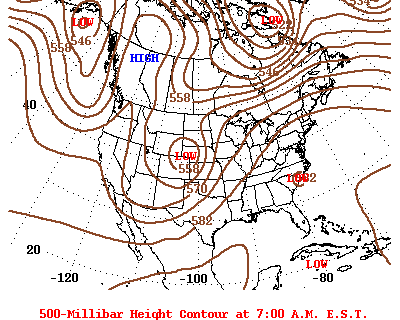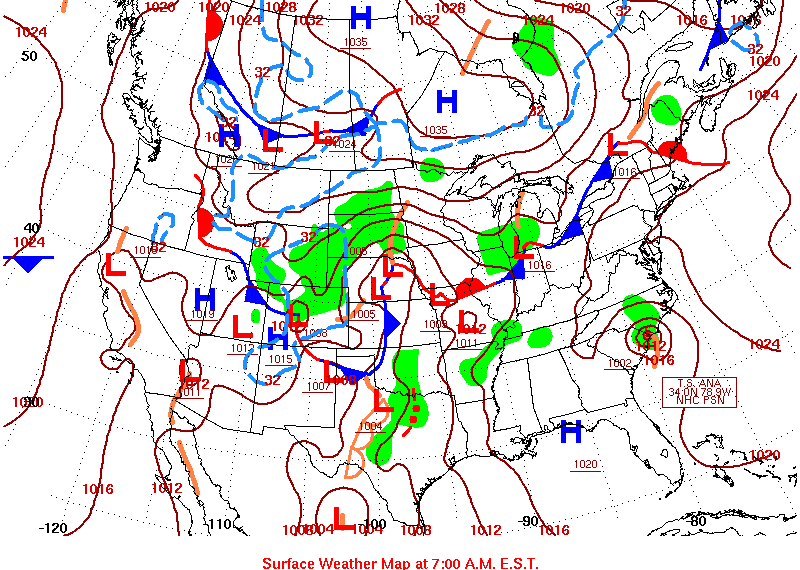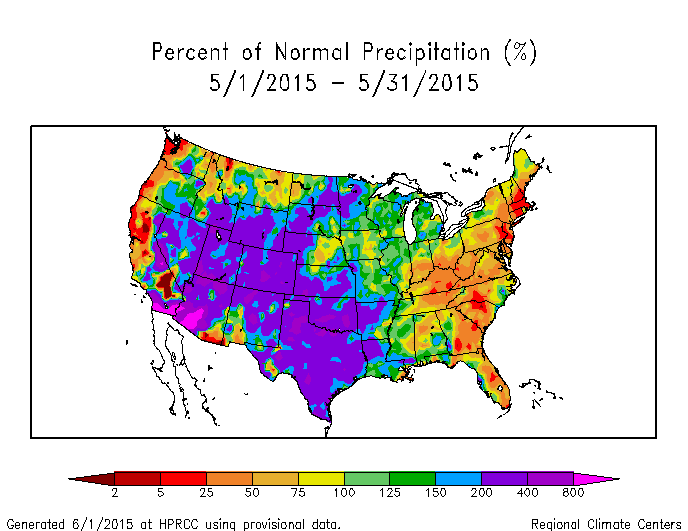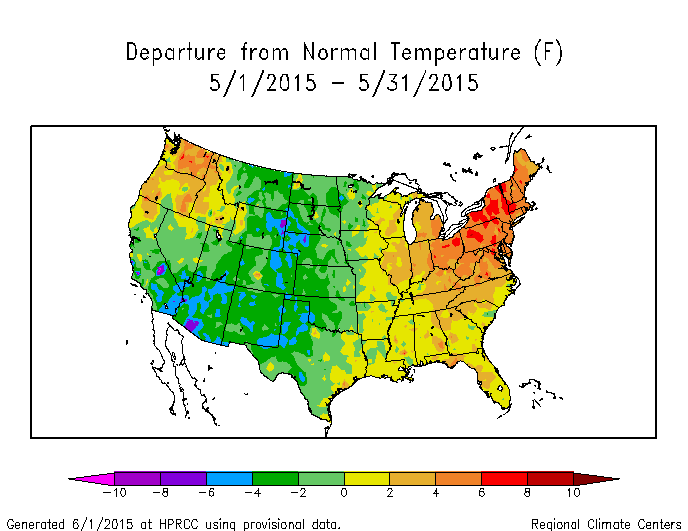Note: This Synoptic Discussion describes recent weather events and climate anomalies in relation to the phenomena that cause the weather. These phenomena include the jet stream, fronts and low pressure systems that bring precipitation, high pressure systems that bring dry weather, and the mechanisms which control these features — such as El Niño, La Niña, and other oceanic and atmospheric drivers (PNA, NAO, AO, and others). The report may contain more technical language than other components of the State of the Climate series.
Summary
May 2015 was characterized by a very active upper-level circulation pattern over the contiguous United States (CONUS), with several weather systems moving in the jet stream flow. These weather systems split the jet stream over western North America, resulting in a long-wave pattern of warm and dry ridge over Alaska and western Canada and a cool and wet trough over the western CONUS. A long-wave ridge controlled the weather over the eastern CONUS for much of the month, resulting in a warmer- and drier-than-normal May in that region. The western trough funneled Gulf of Mexico moisture into the Plains, fueling frequent storm systems which dumped flooding rains over Texas and Oklahoma. The western trough also contributed to conditions which triggered frequent outbreaks of severe weather, especially across the Plains states. Drought expanded in the Northeast, where May compounded earlier dryness, but above-normal precipitation mostly eliminated drought conditions across the Great Plains and reduced drought in parts of the Rockies, contributing to a shrinkage of the national drought footprint. The upper-level circulation, temperature, and precipitation anomaly patterns suggest that the weather and climate of May 2015 were the result of influences from multiple atmospheric drivers originating over the Tropical and North Pacific, with the El Niño playing an important role. See below for details.
Synoptic Discussion
|
In the Northern Hemisphere, May marks the end of climatological spring, which is the transition period between winter and summer. The sun angle gets higher in the sky and solar heating increases, which contracts the circumpolar vortex and causes the jet stream to retreat northward. But this May the jet stream did not go quietly. The long-wave circulation pattern in the upper atmosphere consisted of a ridge over western North America, but the jet stream remained quite active over the western CONUS, resulting in a split flow or what is called a Rex Block. The Rex Block split the circulation so that an upper-level ridge brought warmer- and drier-than-normal weather to Alaska, western Canada, and the Pacific Northwest, while upper-level troughs and closed lows dominated much of the western CONUS, bringing cooler- and wetter-than-normal weather. This was especially the case for much of mid-May (roughly May 7th-24th). The resulting long-wave trough over the western CONUS funneled Gulf of Mexico moisture into the Plains and sent bursts of cyclonic energy, or short-wave troughs, into the Plains. This combination triggered frequent storm systems which dumped flooding rains over Texas and Oklahoma. The western trough also contributed to unstable atmospheric conditions, including a vertical wind pattern that created a spinning motion in the air, which triggered frequent outbreaks of severe weather, especially across the Plains states. There were 412 preliminary reports of tornadoes, which compares to a May average of 276. As another consequence, the western trough forced the creation of an upper-level ridge downstream over the eastern CONUS. The ridge enhanced sunshine and deflected many weather systems away from the East Coast, resulting in a warmer- and drier-than-normal month. The ridge also blocked the movement of Tropical Storm Ana, which developed early in the month off the Southeast Coast of the CONUS. Ana eventually became absorbed into a trough which moved through the ridge several days later. The warm and dry weather helped trigger several large wildfires in the Northeast early in the month and in Alaska later in the month. |
|
The upper-level ridge over western Canada funneled cooler air masses from more northern latitudes southward. As the upper-level troughs and low pressure systems moved out of the western CONUS and into the Plains, they pulled in the Canadian air masses behind them, reinforcing the pattern of cooler-than-normal temperatures across the Plains. Some of the air masses were cold enough, and the low pressure systems strong enough, that the precipitation fell as snow. Snowstorms in the Northern Plains around the 10th-11th and 18th-20th increased the national snow cover area to 5 to 8 percent, but the snow didn't last long in the otherwise well-above-freezing temperatures. Triggered by the western CONUS trough, and fueled by El Niño, record to near-record precipitation occurred over the Southern to Central Plains, helping to alleviate drought conditions. May precipitation was above-normal across much of the West, but this month is in the dry season for most areas, so the precipitation did little to relieve drought conditions across most of the West. The eastern CONUS ridge contributed to expansion of drought in the Northeast. The net effect was a contraction of the overall national drought footprint, with 24.6 percent of the CONUS experiencing moderate to exceptional drought at the end of May, compared to 37.4 percent at the end of April. The rainfall in the Plains was so intense, that it contributed to the wettest May and wettest month ever, nationally, in the 1895-2015 record. The movement of short-wave ridges and troughs within the long-wave circulation pattern brought warm and cold weather episodes to much of the CONUS. By the end of the month, there were 3,030 record warm daily high (837) and low (2,193) temperature records, which is a little more than the 2,400 record cold daily high (1,813) and low (587) temperature records. The monthly average temperature ranked May 2015 as the 48th warmest May in the 1895-2015 record. The REDTI (Residential Energy Demand Temperature Index) for May 2015 ranked 23rd lowest for May, illustrating how the below-normal temperatures in the West and Southern Plains reduced cooling demands there while the above-normal temperatures in the Northeast reduced heating demands in that region. The Climate Extremes Index (CEI) aggregates temperature and precipitation extremes across space and time. Parts of the U.S. experienced temperature and precipitation extremes during May, and when aggregated they gave several regions high CEI values, but none were record high aggregated CEI values. The South region had the ninth most extreme May CEI on record due mostly to the most extreme days with precipitation component and seventh most extreme wet spell component as well as the ninth most extreme cool maximum temperature component. The Southwest region had the eleventh most extreme May CEI on record due to the most extreme days with precipitation component and fifth most extreme cool maximum temperature component. The Northeast region had the eleventh most extreme May CEI on record due to the fourth most extreme warm maximum temperature component, 14th most extreme warm minimum temperature component, eighth most extreme 1-day precipitation component, and 17th most extreme days without precipitation component. The West region had the 17th most extreme May CEI in the 106-year record due largely to the most extreme Palmer drought component. When aggregated across the nation, May had the most extreme days with precipitation component and ninth most extreme cool maximum temperature component, but the national May 2015 CEI was only the 27th most extreme national May CEI on record. |
|
The movement of short-wave troughs and lows through the upper-level circulation across the southwestern CONUS undercut the long-wave ridge pattern over western North America. So, when integrated across the month, the atmospheric circulation indicated a pattern of reduced 500-mb height anomalies over the Southwest, and above-normal anomalies over Alaska, western Canada, and the adjacent northeast North Pacific. This indicated a stronger-than-normal ridge to the north and a trough to the south. Above-normal 500-mb heights (weaker-than-normal long-wave trough) occurred over the eastern CONUS and southeast Canada, likely induced as a downstream effect of the Southwest trough. Below-normal 500-mb heights over northeast Canada and Greenland into the extreme northern North Atlantic reflected a stronger-than-normal trough over these higher latitudes. This overall pattern indicates dichotomy between the high latitude circulation and lower mid-latitude circulation. |
|
Most of the Ohio Valley, Atlantic Seaboard, and West Coast was drier than normal during May 2015. Precipitation was above normal across the Interior West, Southwest, Great Plains, and Great Lakes. Very heavy rains with widespread flooding occurred across the Southern Plains. May was drier than normal across much of Alaska, with stations along the western and northern coasts wetter than normal. The precipitation pattern in the Hawaiian Islands was mixed. |
|
May 2015 temperatures averaged warmer than normal across Alaska, most of the Pacific Northwest, and most of the CONUS east of the Mississippi River. The temperature anomalies were especially warm in the northeastern CONUS. Temperatures were colder than normal across the Great Plains to Southwest. |
Global Linkages: The upper-level circulation anomaly pattern over North America was part of a long-wave pattern that stretched across the Northern Hemisphere. The anomalous ridge over Alaska and western Canada was part of a pair of high latitude anomalous ridge/trough couplets located across North America/the North Atlantic and north central Eurasia/northeast Asia. Further south in the mid-latitudes, the anomalous trough/ridge couplet over the southwestern CONUS/eastern CONUS was unique, because similar trough/ridge couplets were not found across the rest of the Northern Hemisphere at this latitude. The above-normal 500-mb heights were associated with upper-level ridging and above-normal surface temperatures over northwestern and east central North America, north central Eurasia, and southwestern Europe, as well as near to below-normal precipitation and reduced snow cover in these areas. In fact, the May 2015 snow cover extent was the sixth smallest May extent for the Northern Hemisphere, third smallest for North America, and smallest in the 1966-2015 record for Alaska. The below-normal 500-mb heights were associated with upper-level troughing and were reflected by near- to below-normal temperatures at the surface and near to above-normal precipitation. With large portions of the continents having warmer-than-normal temperatures, and large portions of the equatorial Pacific Ocean having warmer-than-normal sea surface temperatures due to El Niño, the May 2015 global temperature was well above normal.
Atmospheric Drivers
Subtropical highs, and fronts and low pressure systems moving in the mid-latitude storm track flow, are influenced by the broadscale atmospheric circulation. The circulation of the atmosphere can be analyzed and categorized into specific patterns. The Tropics, especially the equatorial Pacific Ocean, provides abundant heat energy which largely drives the world's atmospheric and oceanic circulation. The following describes several of these modes or patterns of the atmospheric circulation, their drivers, the temperature and precipitation patterns (or teleconnections) associated with them, and their index values this month:
-
El Niño Southern Oscillation (ENSO)
- Description: Oceanic and atmospheric conditions in the tropical Pacific Ocean can influence weather across the globe. ENSO is characterized by two extreme modes: El Niño (warmer-than-normal sea surface temperature [SST] anomalies in the tropical Pacific) and La Niña (cooler-than-normal SST anomalies), with the absence of either of these modes termed "ENSO-neutral" conditions.
- Status: During May 2015, El Niño conditions were observed as above-average SSTs continued across the western and central equatorial Pacific and continued to be coupled to the tropical atmosphere.
- Teleconnections (influence on weather): To the extent teleconnections are known, the typical temperature and precipitation patterns associated with El Niño during May include above-normal precipitation from the Southern Plains to Southeast and in patchy areas in the Southwest; below-normal precipitation across much of the Northwest, Central Plains to Ohio Valley, Mid-Atlantic States, and northern New England; below-normal temperatures across the Southwest, Northern Plains, and Great Lakes to Northeast; and above-normal temperatures in the Pacific Northwest.
- Comparison to Observed: The May 2015 temperature anomaly pattern agrees with that expected with an El Niño from the West Coast to Great Plains, but not in the Northeast. The May 2015 precipitation anomaly pattern agrees in the Southern Plains and parts of the Pacific Northwest, New England, and Mid-Atlantic States, but not in the Southeast or Central Plains to southern Great Lakes.
-
Madden-Julian Oscillation (MJO)
- Description: The MJO is a tropical disturbance or "wave" that propagates eastward around the global tropics with a cycle on the order of 30-60 days. It is characterized by regions of enhanced and suppressed tropical rainfall. One of its indices is a phase diagram which illustrates the phase (1-8) and amplitude of the MJO on a daily basis. The MJO is categorized into eight "phases" depending on the pattern of the location and intensity of the regions of enhanced and suppressed tropical rainfall. The MJO can enter periods of little or no activity, when it becomes neutral or incoherent and has little influence on the weather. Overall, the MJO tends to be most active during ENSO-neutral years, and is often absent during moderate-to-strong El Niño and La Niña episodes.
- Status: The MJO index was incoherent for most of May, ending the month weakly in phase 1. The MJO indices appeared to be influenced by other modes of coherent subseasonal tropical variability, including the background El Niño state and Kelvin waves (MJO updates for May 4, 11, 18, 25, and June 1).
- Teleconnections (influence on weather): The MJO's temperature and precipitation teleconnections to U.S. weather depend on time of year and MJO phase. To the extent teleconnections are known, the April-June teleconnections for temperature are shown here and for precipitation are shown here.
- Comparison to Observed: The MJO is transitory and can change phases (modes) within a month, so it is more closely related to weekly weather patterns than monthly. The May 2015 monthly temperature and weekly (week 4) temperature anomaly patterns do not match those expected with MJO phase 1. The monthly precipitation and weekly (week 4) precipitation anomaly patterns generally match that expected for phase 1 in most areas.
- The Pacific/North American (PNA) pattern
- Description: The PNA teleconnection pattern is associated with strong fluctuations in the strength and location of the East Asian jet stream. PNA-related blocking of the jet stream flow in the Pacific can affect weather downstream over North America, especially the West and especially in the winter half of the year.
- Status: The daily PNA index was neutral to slightly positive during the month, averaging near zero (neutral) for the month as a whole. The 3-month-averaged index was also near zero.
- Teleconnections (influence on weather): There are no teleconnections for a neutral PNA.
- Comparison to Observed: The May 2015 temperature, precipitation, and upper-level circulation anomaly patterns do not agree with those expected for either a positive or negative PNA.
- The Arctic Oscillation (AO) pattern
- Description: The AO teleconnection pattern relates upper-level circulation over the Arctic to circulation features over the Northern Hemisphere mid-latitudes and is most active during the cold season.
- Status: The daily AO index was neutral to positive, averaging positive for the month. The 3-month-averaged index was positive.
- Teleconnections (influence on weather): To the extent teleconnections are known, a positive AO this time of year (April-June) is typically associated with dry conditions from the Northern and Central Rockies to the Mid-Atlantic and Northeast, snf parts of the West Coast; wet conditions in eastern Texas and parts of Georgia; above-normal temperatures from the Southern and Central Rocky Mountains to the Great Lakes, near normal temperatures elsewhere; and upper-level circulation anomalies which are below normal across the Arctic into northern North America and Alaska, and above normal over the eastern CONUS, North Atlantic and North Pacific.
- Comparison to Observed: The May 2015 monthly upper-level circulation anomaly pattern agrees in the eastern CONUS, but not elsewhere. The precipitation anomaly pattern shows some agreement in the Ohio Valley to Northeast, but not in the Plains to Rockies. The temperature anomaly pattern does not match.
- The North Atlantic Oscillation (NAO) pattern
- Description: The NAO teleconnection pattern relates upper-level circulation over the North Atlantic Ocean to circulation features over the Northern Hemisphere mid-latitudes.
- Status: The daily NAO index was neutral to slightly positive, averaging slightly positive for the month. The 3-month-averaged index was positive.
- Teleconnections (influence on weather): To the extent teleconnections are known, a positive NAO during this time of year (April on the teleconnection maps) is associated with drier-than-normal conditions in the Southeast, Central Plains, and parts of the West (although the teleconnections are weak for precipitation); warmer-than-normal temperatures everywhere in the CONUS except the Gulf of Mexico coast to Mid-Atlantic; positive upper-level circulation anomalies across the North Atlantic and most of the CONUS, and negative upper-level circulation anomalies over the Canadian Archipelago and Greenland.
- Comparison to Observed: The May 2015 precipitation anomaly pattern agrees with that for a positive NAO in the Southeast and northern California, but not in the Central Plains. The monthly temperature and upper-level circulation anomaly patterns show little agreement.
- The West Pacific (WP) pattern
- Description: The WP teleconnection pattern is a primary mode of low-frequency variability over the North Pacific and reflects zonal and meridional variations in the location and intensity of the (East Asian) jet stream in the western Pacific.
- Status: The monthly WP index was positive for the month, while the three-month average WP index was increasingly positive.
- Teleconnections (influence on weather): To the extent teleconnections are known, a positive WP during this time of year (April on the maps) is typically associated with below-normal temperatures in the Southwest, above-normal temperatures from the Ohio Valley to Northern Plains, drier-than-normal conditions in the Northwest, and below-normal circulation anomalies over the southwestern CONUS and above-normal circulation anomalies over the Northern Plains (although the precipitation and circulation teleconnections are weak).
- Comparison to Observed: The May 2015 monthly temperature anomaly pattern agrees in the Ohio Valley and Southwest, but not Northern Plains. The precipitation anomaly pattern agrees in the Northwest, but there is little correlation elsewhere. The upper-level circulation anomaly pattern agrees with that expected for a positive WP where there are correlations (Southwest and Northern Plains).
- The East Pacific-North Pacific (EP-NP) pattern
- Description: The EP-NP teleconnection pattern relates SST and upper-level circulation patterns (geopotential height anomalies) over the eastern and northern Pacific to temperature, precipitation, and circulation anomalies downstream over North America. Its influence during the winter is not as strong as during the other three seasons.
- Status: The May SST pattern showed above-normal SSTs along the North American coast and cooler-than-normal SSTs in the central North Pacific. The magnitude of the warmth of the SSTs in the northeastern North Pacific increased this month in the Gulf of Alaska region and decreased slightly along the immediate U.S. West Coast. The monthly EP-NP index was positive during May, while the 3-month running mean was still in positive territory but close to zero.
- Teleconnections (influence on weather): To the extent teleconnections are known, a positive EP-NP index during this time of year (April on the maps) is typically associated with cooler-than-normal temperatures east of the Rockies, warmer-than-normal temperatures across the extreme West Coast and in Alaska, wetter-than-normal conditions in Wyoming and parts of the Ohio Valley (although the precipitation teleconnections are very weak), above-normal upper-level circulation anomalies (stronger upper-level ridge) over Alaska and western Canada and into the western CONUS, and below-normal upper-level circulation anomalies (stronger upper-level trough) over the northeastern CONUS, eastern Canada, and the central North Pacific.
- Comparison to Observed: The May 2015 upper-level circulation anomaly pattern agrees with a positive EP-NP pattern over Alaska, but not over the central North Pacific or eastern North America. The May temperature anomaly pattern shows some agreement over the Plains, but is opposite that expected in the East. The precipitation anomaly pattern shows some agreement in Wyoming but few teleconnections exist.
Examination of these circulation indices and their teleconnection patterns, and comparison to observed May 2015 temperature, precipitation, and circulation anomaly patterns, suggest that the weather over the CONUS in May reflected influences from several atmospheric drivers. The El Niño funneled energy and moisture from the eastern equatorial Pacific across Mexico and into the U.S. Southern Plains. The Gulf of Mexico also served as a moisture source. The MJO was incoherent for most of the month, but its teleconnections for phase 1 suggest it played a role in the wet conditions over the Southwest. The dryness in the East correlates with the El Niño (Northeast) and NAO (Southeast), which suggests they had an influence. Temperatures were likely influenced by the Tropical and North Pacific atmospheric drivers, as indicated by the El Niño and WP teleconnections. The upper-level circulation pattern likely reflected internal mid-latitude variability, although the teleconnections with the WP in the Southwest and Northern Plains, and EP-NP over Alaska, suggest the North Pacific drivers had some influence. The PNA and AO indices suggest the Arctic drivers did not appear to have much influence on May's weather in the CONUS.
This month illustrates how the weather and climate anomaly patterns can reflect the combined influence of several atmospheric drivers (or modes of atmospheric variability), especially those originating from the Tropical and North Pacific, as well as random variability.
 NOAA's National Centers for Environmental Information
NOAA's National Centers for Environmental Information





